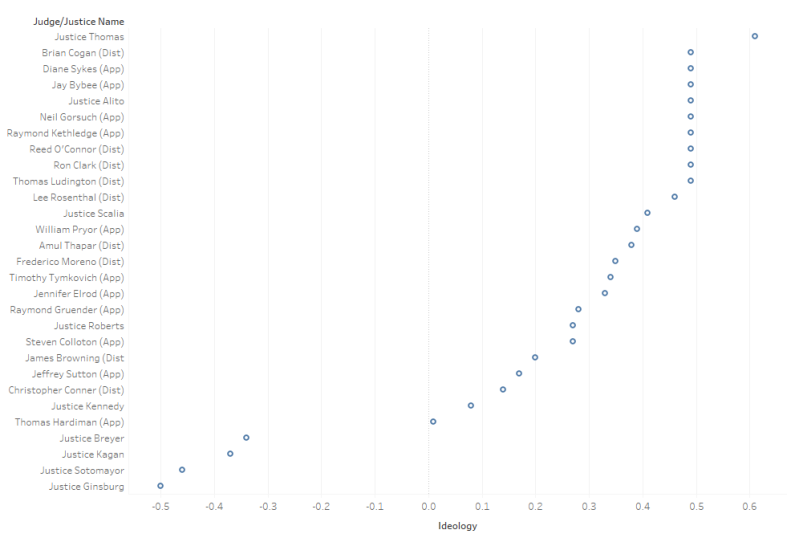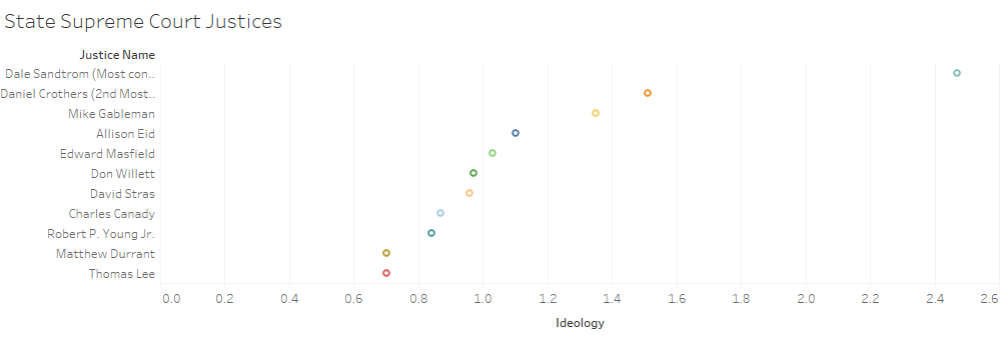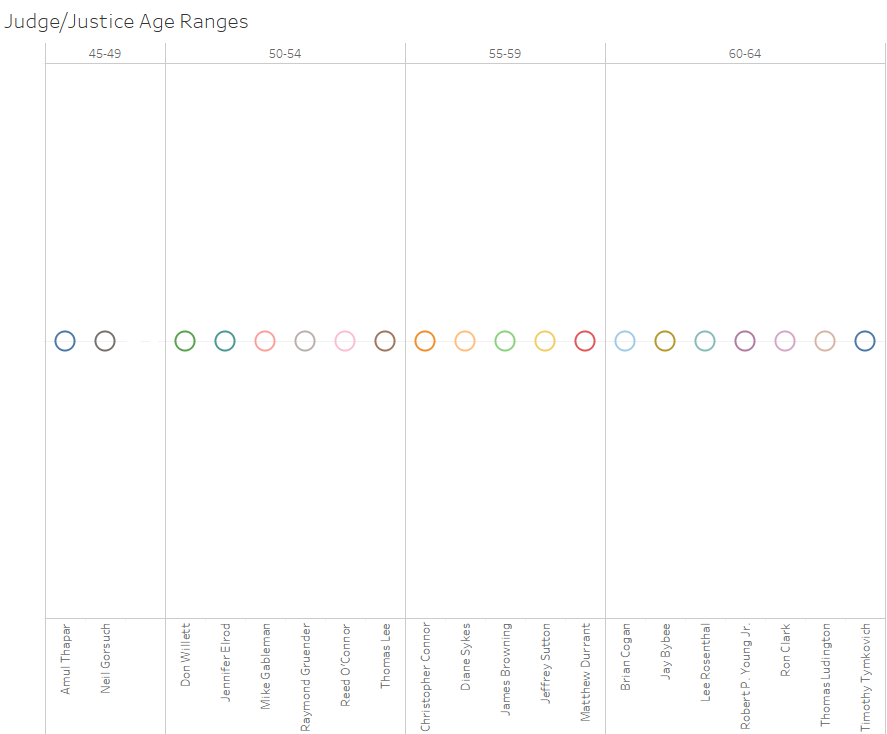Making sense out of who Donald Trump may nominate to the Supreme Court is a very different exercise than doing the same for Hillary Clinton. Trump, unlike Clinton, is not a career politician, and he has campaigned on a platform designating himself as an outsider looking to reform the Washington establishment. Trump’s list of potential nominees varies considerably from the norm of judicial candidates for the Supreme Court in recent years. While aside from Justice Kagan all sitting Justices worked on a federal court of appeals prior to their nomination to the Court (Kagan was a United States Solicitor General, the top lawyer for the federal government from 2009 until she was nominated to the Supreme Court in 2010), Trump’s list includes state supreme court justices, federal district court judges, and a U.S. Senator.
While one might have expected Clinton to select nominees based on typical criteria, the qualities Trump is looking for in a candidate may very well differ. Since early in his presidential campaign, Trump has focused his description of potential Supreme Court nominees on the basis of policy positions more than on credentials. With this in mind I provide several tiers of Trump’s possible federal judicial candidates. The foremost criterion for these candidates is their policy positions – specifically those positions Trump has designated as important to his Supreme Court nominee(s) through his presidential campaign.
Criteria
To create this list I focused on federal and state court judges. The vast majority of individuals on Trump’s list are current judges and judges have a judicial record that conveys how they might rule in potential Supreme Court cases. Comparing judges to judges is also more straightforward than comparing judges to politicians, lawyers, or other classes of individuals within the universe of Trump’s potential candidates. Beyond this, the focus is a judge’s policy positions through their rulings. I look for judges whose decisions or positions either align with Trump’s on (1) abortion, (2) gun rights, (3) the Affordable Care Act (ACA), or (4) marriage equality, and/or whose decisions are steeped in an original understanding of the Constitution (for Originalism I looked for certain markers in the judges’ decisions that demonstrated repeated analyses premised on original understandings of the Constitution and then rank the judges as heavy originalists or moderate originalists).
The candidates below are selected only based on these criteria and as a result of boolean searches within their decisions in the five areas of interest. If, based on their decisions, they meet these criteria and are on Trump’s list then they are top tier candidates as this convergence presents a high likelihood that the judge is a strong candidate to be a Trump nominee. Since there is great potential for Trump’s list to shift by the time he makes his nomination(s), I did not base my decisions exclusively on Trump’s – that is, I did not necessarily include Trump’s picks in my own if they did not converge on the policy/interpretive criteria.
As Supreme Court nominees are given life tenure, there is strong reason to expect Trump will focus on younger nominees that are more likely to remain in the position for years to come. This can be a staple of any President’s legacy. I therefore looked at judges currently at or below the age of 65.
The three tiers of candidates are top tier candidates, candidates that are on the fence, and those just below the fence that still may be nominated to judicial office now or in the near future under a Trump administration. I discuss many of these judges and justices relative judicial ideologies after I go through the potential nominees.
Top Candidates
The two main factors to make it to the top category were either a strong classification in one of the described policy and/or interpretation categories, or at least a moderate showing in one or more of the categories and a position on Trump’s list. Just to reiterate, the only hard and fast criteria for a judge to make any of the tiers in this list is a judge’s policies and interpretation as is evident from their judicial decisions.
These ten judges/justices include Neil Gorsuch, Jeffrey Sutton, Diane Sykes, Raymond Gruender, Jennifer Elrod, Amul Thapar, Thomas Lee, Robert Young, Timothy Tymkovich, and Don Willett. Although the list isn’t sequenced, based on decision-making, experience, age, and Trump’s list, 10th Circuit Judge Neil Gorsuch presents himself as a potential leader among the candidates.
Below I briefly go through reasons why these judges/justices are in the top tier, look at their judicial experience, and describe their likelihood of nomination.
Gorsuch was on Trump’s shortlist of nominees. Although he has not written a decision in any of the controversial policy areas, he regularly uses originalist principles in his decisions (I classified him as a heavy originalist based on the originalist indicators in his decisions). While Trump does not seem set on typical Supreme Court candidacy criteria for his nominees, these should not hurt a potential nominee. Gorsuch attended Harvard law, was a Supreme Court clerk, and worked in the Department of Justice prior to his appointment to the 10th Circuit. He is also respected for his handling of complex legal matters. His take on executive agency interpretation of the law received positive responses from many respected judicial scholars. Gorsuch is also in the younger age bracket of the potential nominees at 49 and ranks highly conservative based on his perceived ideology.
Although not on Trump’s list, many previous expected Sutton, a respected conservative judge, would be one of Trump’s top choices. Sutton, a current 6th Circuit judge, makes the top tier of candidates because of decision on marriage equality and because he falls into the moderate originalism category based on indicators in his decisions. Sutton is also a former Supreme Court clerk.
Judge Sykes was mentioned in Trump’s list of potential nominees. Sykes serves on the 7th Circuit Court of Appeals. She remains a strong candidate, however, based on the policies established in her decisions. Along with a conservative bent, Sykes has been criticized for her anti-abortion positions. Sykes also wrote a majority decision ruling against the contraceptive coverage provision of the ACA.
Judge Gruender who currently sits on the 8th Circuit Court of Appeals was another candidate on Trump’s list of potential nominees. Gruender has voted in several instances to uphold abortion restrictions and has written judicial opinions to this effect as well. Gruneder was nominated to the 8th Circuit by President George W. Bush in 2003 and his ideology score is moderately conservative.
Judge Elrod, another potential nominee left off of Trump’s list, was the opinion author of a Texas anti-abortion decision that was overturned by the Supreme Court in Whole Woman’s Health v. Hellerstedt. Elrod sits on the 5th Circuit Court of Appeals and is often noted as conservative judge although she has also been described as a centrist.
Thapar is currently a federal district court judge in the Eastern District of Kentucky. Another one of the younger potential nominees, Thapar was also included on Trump’s list. Thapar’s decisions place him as a moderate originalist which strengthens his potential candidacy. Thapar’s legal experience also includes work in the U.S. Attorney General’s Office. Thapar’s noted decisions include giving lengthy sentences to protestors at a Y-12 Nuclear Security Complex.
Lee is a current justice on the Utah Supreme Court. He was included on Trump’s list and his decisions place him in the heavy originalist category. His also authored an anti-abortion opinion on the Utah Supreme Court that sought to treat a fetus as a minor child under the law. Lee clerked for Supreme Court Justice Thomas after completing law school and has an extensive career in litigation. His brother, Senator Mike Lee of Utah is another member on Trump’s list of potential nominees. Lee previously worked in the Justice Department.
Justice Young is the oldest judge on my list at 65. He falls into the moderate to heavy originalist category. Young was also on Trump’s list of potential nominees. His rulings include a decision in In Re Request for Advisory Opinion Regarding the Constitutionality of 2005 PA 71 (2007) upholding restrictive voting standards.
Judge Tymkovich is another potential nominee from Trump’s list. He currently sits on the 10th Circuit Court of Appeal as Chief Judge. Judge Tymkovich worked in the Colorado Attorney General’s Office as the state Solicitor General prior to his nomination to the 10th Circuit. In this position, he argued before the Supreme Court in Romer v. Evans in support of Colorado’s Amendment 2, which was designed to prevent discrimination claims from same sex couples. He ranks as a moderate originalist and was the author of the Hobby Lobby decision in the lower court – another ruling that struck down the contraceptives provision in the ACA.
Justice Willett is the final candidate in the top tier category. A social media maven and a member of Trump’s potential nominee list, Justice Willett is a strong candidate notwithstanding his Twitter critiques of Trump (Trump has often reacted harshly even to comedic public criticism). He meets the criteria for this tier with strong, originalist decisions (as is evident in this recent case dealing with school finance), and has been described as “the most conservative justice on the Texas Supreme Court.” He has yet to tackle some of the more controversial policy issues in his authored decisions.
On the Fence
Many of these potential nominees’ rulings voiced strong opposition to parts of the President Obama’s Affordable Care Act.
Judge Clark currently is the Chief judge for United States District Court for the Eastern District of Texas. Born in 1953 his is one of the older members of this list. He is a moderate originalist in his decisions and the author of a decision that the contraceptives provision in the ACA violated the First Amendment rights of religious corporations.
Judge Rosenthal sits on the Federal District Court for the Southern District of Texas and was nominated to that court by President George H. W. Bush in 1992. She is also on the older end of the age bracket for potential nominees. Similar to Judge Clark, Rosenthal was the author of a decision striking down the contraceptives provision of the ACA.
Judge Connor, a Federal District Judge for the Middle District of Pennsylvania ruled the individual mandate in the ACA was an unconstitutional abuse of Congressional power. Like several of the judges on this list, Connor was appointed to the district court by President George W. Bush.
Cogan is another judge that ruled against the contraceptives provision in the ACA. His decisions are moderately originalist. He also ranks towards the top level of conservativism based on his federal judge ideology score.
Justice Durrant, the last judge in this category is also the only judge in this category from a state Supreme Court (he is the Chief Justice of the Supreme Court of Utah). Durrant conveys an originalist perspective in many of his decisions, which include ruling against bigamist marriages. He has also made several pushes for criminal justice reform in Utah.
Other Potential Nominees
Browning is a George W. Bush nominee to the District Court of New Mexico. Browning is a heavy originalist, which is apparent in many of his opinions including in the recent decision, Swepi, LP v. Mora County.
Judge Bybee is a 9th Circuit Judge appointed by George W. Bush. He is a moderate originalist as well as one of the authors of the now infamous “torture memos” for interrogation procedures under the Bush regime. Bybee’s past experience includes work as a White House Associate Counsel and work in the Department of Justice.
Gableman who sits on the Wisconsin Supreme Court ranks as a moderate originalist. Although caught up in past controversy because of a previous campaign ad, he is also one of the most conservative state supreme court justices (see the figure below). Despite his originalist interpretation and conservativism, Justice Gableman’s history may prevent his rise in the federal courts.
Judge O’Connor, a District Court Judge for the Northern District of Texas, recently made headlines for granting an injunction against the Obama Administration’s transgender restroom policy. O’Connor was a George W. Bush appointee to the district court, ranks as a moderate originalist in his interpretation, and remains a strong candidate for a higher position under the Trump administration.
Judge Ludington sits in the Federal District Court for the Eastern District of Michigan. He ranks as a moderate originalist and was a George W. Bush appointee to the district court. Ludington has authored several significant conservative decisions including striking down a Title VI discrimination complaint against Central Michigan University. Ludington was previously involved in a controversy involving federal judges’ campaign contributions to Republican political candidates.
Finally, there are intermediate/lower court state judges who are noteworthy for their originalist approaches to interpretation. The first, Judge Bowes sat on the Pennsylvania Superior Court since 2002. Bowes aligns herself with the Republican Party and was in the news earlier this year for throwing out perjury and obstruction of justice charges against former Penn State University president Graham Spanier and former vice president Gary Schultz .
Along with Justice Willett, Judge Dillard has one of the largest judicial presences on social media. Like Judge Bowes, Judge Dillard regularly employs originalist principles in his decisions as are evident in this decision in the case of Six Flags Over Georgia v. Martin (2015). Although he recently decided not to pursue an appointment to the Georgia Supreme Court, Dillard was mentioned as a possible nominee for a federal judicial position in the Trump administration.
Ideology
Below is a quick look at many of these judges and justices judicial ideologies. Federal court judges, including Supreme Court Justices are analyzed separately from state supreme court justices. The first figure looks at all of my federal judge candidates, along with the remainder of Trump’s list, and the current Supreme Court Justices (plus Justice Scalia) on the same scale (this was compiled using Judicial Common Space Scores with Christina Boyd’s supplement of federal district court judge scores). Current district court judges are designated by (Dist) and current court of appeals judges are designated by (App). More conservative judges have higher scores.

Although these candidates are on the same scale and are thus united by a comparable measure, one important caveat: only Supreme Court Justices’ ideologies account for their judicial decisions (I used their ideology scores from the most current Term of the JCS). The federal district and court of appeals judges’ ideologies are based on their appointing Presidents. The potential nominees’ ideologies therefore might not directly translate into a conservativism measure for the Supreme Court.
While state court judges are not on the same scale, scholars previously proxied their ideologies based on campaign finance contributions. Although these scores are not on the same scale as those for federal court judges and justices, they provide a means to compare the relative ideologies of state court justices. Here also I include the nominees on Trump’s list as well as my own for whom we have available data. Along with these potential nominees I include the two most conservative state supreme court justices on this scale to give a sense of where the potential nominees fit in. Once again, more conservative justices have higher scores.

For a quick run through of all of the potential nominees covered in the three tiers above and the age brackets they fit into, see the figure below.

On Twitter: @AdamSFeldman
Updated: 11/15/2016
12 Comments Add yours